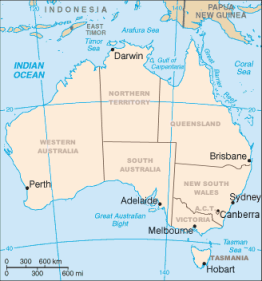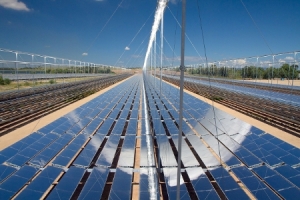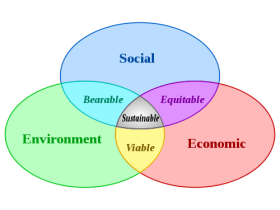Archive for the ‘Economics’ Category
Inclusive growth and climate change adaptation and mitigation in Australia and China: Removing barriers to solving wicked problems
 This reports aims to assist the Sino-Australian bilateral relationship adapt to meet China’s new policies and to facilitate a smoother transition to a low carbon future. Southwest University of Finance and Economics (SWUFE), Chengdu, China and the University of Queensland, Brisbane, Australia held a workshop at SWUFE to develop a guide to China’s low-carbon policies and their implications for the Sino-Australian energy trade and sectors. This report results from the workshop. Chapter 3 contains the guide to China’s low emission policies and discusses market-based experiments within China’s command-and-control electricity sector. Chapter 4 discusses Australia’s poorly implemented neoliberal policies within its energy sector and provides an informative market-based case study for China on what to avoid. Chapter 2 discusses the implications of Australia and China’s low emission policies. Chapter 5 discusses barriers to the transition to a low emissions economy.
This reports aims to assist the Sino-Australian bilateral relationship adapt to meet China’s new policies and to facilitate a smoother transition to a low carbon future. Southwest University of Finance and Economics (SWUFE), Chengdu, China and the University of Queensland, Brisbane, Australia held a workshop at SWUFE to develop a guide to China’s low-carbon policies and their implications for the Sino-Australian energy trade and sectors. This report results from the workshop. Chapter 3 contains the guide to China’s low emission policies and discusses market-based experiments within China’s command-and-control electricity sector. Chapter 4 discusses Australia’s poorly implemented neoliberal policies within its energy sector and provides an informative market-based case study for China on what to avoid. Chapter 2 discusses the implications of Australia and China’s low emission policies. Chapter 5 discusses barriers to the transition to a low emissions economy.
Climate change is one of the world’s major challenges. Others include increasing inequality and poor economic growth, creating a decline in inclusive growth. Declining inclusive growth and climate change are interrelated wicked problems. Their solution is technically and economically viable given appropriate investment but the absence of a price on carbon in Australia is a major obstacle to directing investment consistent with a low emissions future.
Australia is transitioning from a mining to a more service orientated economy. However, Australia’s uncoordinated energy and climate change policy and poorly implemented neoliberal policies in the energy sector are undermining investment confidence and hindering both inclusive growth and the transition to a lower emissions economy. Energy and climate change policies need bring together to restore investment confidence within the electricity sector. The Integrated Systems Plan has gone some way to address this problem. Similarly, Australia’s uncoordinated growth and climate change policies are hindering inclusive growth and the transition to a lower emissions economy. Growth and climate change policies need bringing together to engender confidence and direct investment compatible with a low emissions future. Notably, Infrastructure Australia has gone some way to address this issue at the national level but the lack of transparency and independence in other jurisdictions undermines Infrastructure Australia’s effectiveness.
Poor policy coordination is also hindering solutions to a host of other interrelated wicked problems. These wicked problems include massive increases in retail electricity prices, private school fees and private health insurance, the inability to undertake major tax reform, such as introducing a tax on sugar or carbon or introduce road user charges to replace the declining revenue from fuel excise duty. There is ample and sound evidence-based research to solve these wicked problems but there is an inability to enact policy in the interest of the electorate.
The key findings of this report are four common barriers to enacting policy to solve these wicked problems.
(1) Political donations present a conflict of interest.
(2) Adversarial politics and political wedging reduce the ability to address complex problems.
(3) There is an absence of academic economists informing the public debate to provide impartial advice.
(4) Unrealistic models of the economy and human behaviour are misinforming policy.
Collinsville solar-gas hybrid project: meeting the climate change challenge by combing proven technologies in a new way and reusing existing infrastructure
RATCH Australia (RAC 2013) in conjunction with the University of Queensland (UQ) are researching the feasibility of a hybrid gas-concentrated solar power (CSP) plant using Linear Fresnel Reflector (LFR) technology to replace the coal fired power station at Collinsville, Queensland, Australia. The project is supported by the Australian Renewable Energy Agency (ARENA) and administered by the Global Change Institute at UQ.
Both the gas generation and LFR technology are proven technologies and both boil water to drive a generator to produce power. The LFR uses ground level mirrors to concentrate the suns energy onto a higher re-concentrator mirror that focuses the energy onto a pipe containing water to produce steam for the generator, see Figure 1.
Figure 1: Concentrated Linear Fresnel Reflector
The combined gas-solar plant allows the plant to maintain a constant electricity output because the gas boiler operates when the sun does not shine. Table 1 shows the proposed electricity output by hour of week. This constant electricity power output during the week avoids the variability of solar generation, which allows the plant to operate as a baseload plant in a similar way to coal-fired power stations. Both the solar boiler and gas boiler can use the same generator therefore saving on capital investments. A team from the School of Mining and Mechanical Engineering are researching issues surrounding duel boiler use of the same generator (Singh & Gurgenci 2014). Another team is investigating techniques to keep the mirrors clean (Guan, Yu & Gurgenci 2014).
Table 1: Proposed plant’s total electricity output by hour of week
| Time | Dispatch (MW) |
| Weekdays: 8am-10pm | 30 |
| Weekdays: 7am-8am | ramp from 0 to 30 |
| Weekends | entire yield of the solar thermal component |
(Source: Bell, Wild & Foster 2014a)
The transmission lines to connect a generator to the electricity grid can cost a million dollars or more a kilometre, therefore reusing the existing transmission lines at Collinsville is not only a major savings in capital investment but saves on producing CO2 emissions that would otherwise be required to produce the steel and other metals for connection to the grid. A team from the School of Information Technology and Electrical Engineering are researching grid stability issues (Shah, Yan & Saha 2014).
This project provides a template for future hybrid schemes because Australia’s ageing coal-fired power stations are close to retirement and their grid connections will become available to similar renewable schemes. The hybrid schemes also allow the transition and retraining of fossil people into renewable people.
A team from the Energy Economics and Management Group, School of Economics is forecasting the lifetime yield of the solar plant (Bell, Wild & Foster 2014b) and revenue and dispatch of the plant (Bell, Wild & Foster 2014a). These forecasts both help determine the financial feasibility of the plant and help secure a power purchase agreement for the power produced. Seven ‘Collinsville solar thermal project’ reports are due for publication in November or December this year; the draft reports were due in May this year. Please correspond with the authors if you have any questions.
References
Guan, Z, Yu, S & Gurgenci, H 2014, Collinsville solar thermal project: Solar mirror cleaning requirements, University of Queensland, Brisbane, Australia.
Novatec Solar 2014, ‘Novatec Solar’, viewed 12 Jul 2014 <http://www.novatecsolar.com/20-1-Nova-1.html>.
RAC 2013, ‘Collinsville Energy Park’, RATCH-Australia Corporation Limited, <http://ratchaustralia.com/Collinsville%20Energy%20Park.html>.
Shah, R, Yan, R & Saha, T 2014, Collinsville solar thermal project: Power system assessment, University of Queensland, Brisbane, Australia.
Singh, R & Gurgenci, H 2014, Collinsville solar thermal project: Fossil fuel boiler integration, University of Queensland, Brisbane, Australia.
Progressing from game theory to agent based modelling to simulate social emergence
 This article discusses some of the fundamental flaws in game theory and discusses agent based modelling as a successor to model social emergence.
This article discusses some of the fundamental flaws in game theory and discusses agent based modelling as a successor to model social emergence.
Axelrod (1984) made a major contribution to Game Theory in his book “Evolution of Cooperation” but thirteen years later he, dissatisfied with game theory, moves onto agent based modelling to rework his view of cooperation in his book in 1997 “The complexity of Cooperation: Agent-based Models of Competition and Collaboration”. In a similar move, the Santa Fe Institute in the US was established in 1984 to grapple with complex social issues and used agent based modelling amongst other techniques to “collaborate across disciplines, merging ideas and principles of many fields — from physics, mathematics, and biology to the social sciences and the humanities — in pursuit of creative insights that improve our world”. Additionally, the EU acknowledges the failure of traditional economics so adopts agent based modelling.
Agent based modelling captures the interaction between agents to simulate emergence whether at the physical or social level. NetLogo provides an extensive library of simulations of both physical and social emergence that shows the diversity of application of agent based modelling. These sample simulations can be readily tailored to meet the needs of social scientists. The software is free and there is a thriving enthusiastic community support group.
Why is there a move by a prominent game theorist, the Santa Fe Institute and the EU to agent based modelling? The article Game Theory as Dogma by Professor Kay (2005) discusses ample reasons to search for alternative techniques to model competition and collaboration and emergence in general. For instance,
The trouble with game theory is that it can explain everything. If a bank president was standing in the street and lighting his pants on fire, some game theorist would explain it as rational. (Kay 2005, p. 12)
Formation of the World Economics Association (WEA) a positive outcome from the Global Financial Crisis (GFC)
 One positive aspect of the global financial crisis (GFC) is the clarity of the failure of neoclassical economics to predict the crisis and of its complicity in fermenting the crisis. This clarity of failure and complicity is positive because failure is a source of learning that is to take a new direction away from the neoclassical favoured by the American Economics Association and its journals and their hold on the profession. The newly formed World Economics Association (WEA) provides the economics profession such an avenue. An open letter to join the association is below. Read the rest of this entry »
One positive aspect of the global financial crisis (GFC) is the clarity of the failure of neoclassical economics to predict the crisis and of its complicity in fermenting the crisis. This clarity of failure and complicity is positive because failure is a source of learning that is to take a new direction away from the neoclassical favoured by the American Economics Association and its journals and their hold on the profession. The newly formed World Economics Association (WEA) provides the economics profession such an avenue. An open letter to join the association is below. Read the rest of this entry »
The impact of a carbon price on electricity prices in Australia
 The University of Queensland News discusses the study ‘The Impact of Carbon Pricing on Wholesale Electricity Prices, CarbonPass-Through Rates and Retail Electricity Tariffs in Australia‘, stating that the study is the most accurate estimate to date for the impact of the carbon price on retail electricity prices and reveals the burden will vary considerably, depending on a household’s location.
The University of Queensland News discusses the study ‘The Impact of Carbon Pricing on Wholesale Electricity Prices, CarbonPass-Through Rates and Retail Electricity Tariffs in Australia‘, stating that the study is the most accurate estimate to date for the impact of the carbon price on retail electricity prices and reveals the burden will vary considerably, depending on a household’s location.
Tasmanians, with a relatively low carbon footprint, are set to gain significantly from the carbon price once tax and pension changes are factored in, while Queenslanders — heavily dependent on coal to generate electricity — will wear the biggest increase in power prices, according to economic models run on “supercomputers” at The University of Queensland.
The study estimates an average 8.9 per cent increase for retail electricity prices in the five eastern states, due to the carbon price — below the 10 per cent rise estimated by the federal Treasury. This runs counter to claims that Treasury has underestimated the impact of the carbon price on the economy. Read the rest of this entry »
Termination of the history of economics courses contributing to the Global Financial Crisis (GFC)
Helge Nome : The key to controlling humans does not lie in building fences around them, but to steer their minds away from unwanted questions.
 The elimination of courses in the history of economics has contributed to the Global Financial Crisis (GFC) by eroding institutional memory that allowed the dismantling of structures designed to prevent a re-occurrence of the Great Depression. With little space in the curriculum for reflection on the past, graduate economists feed on a diet of neoclassical mathematics produces an extreme form of bounded rationality where history is both irrelevant and unknown, which makes for a very powerful ideology by steering minds away from unwanted questions. Read the rest of this entry »
The elimination of courses in the history of economics has contributed to the Global Financial Crisis (GFC) by eroding institutional memory that allowed the dismantling of structures designed to prevent a re-occurrence of the Great Depression. With little space in the curriculum for reflection on the past, graduate economists feed on a diet of neoclassical mathematics produces an extreme form of bounded rationality where history is both irrelevant and unknown, which makes for a very powerful ideology by steering minds away from unwanted questions. Read the rest of this entry »
Real Business Cycle (RBC) and Rational Expectations Hypothesis (REH) contributing to the Global Financial Crisis (GFC) and the Dynamite Prize
 This article discusses how neoclassical economics has contributed to the Global Financial Crisis (GFC). In particular, how two neoclassical theories, the Real Business Cycle (RBC) and the Rational Expectations Hypothesis (REH) contributed to the GFC and how these theories are false and unscientific.
This article discusses how neoclassical economics has contributed to the Global Financial Crisis (GFC). In particular, how two neoclassical theories, the Real Business Cycle (RBC) and the Rational Expectations Hypothesis (REH) contributed to the GFC and how these theories are false and unscientific.
Edward C. Prescott and Finn E. Kydland were awarded the 2004 Nobel prize in economics for their work in developing the RBC and Robert E. Lucas Jr. was awarded the 1995 Nobel prize in economics for developing the REH. They have been nominated for The Dynamite Prize in Economics that is to be awarded to the three economists who contributed most to enabling the GFC. The Dynamite Prize in Economics nominates Prescott and Kydland ‘for jointly developing and popularizing “Real Business Cycle” theory, which by omitting the role of credit greatly diminished the economics profession’s understanding of dynamic macroeconomic processes’ and nominates Lucas for ‘his development of the rational expectations hypothesis, which defined rationality as the capacity to accurately predict the future, both served to maintain Friedman’s proposition that monetary factors do not affect the real economy and, in the name of “rigor”, distanced economics even further from reality than Friedman had thought possible.’ Read the rest of this entry »
G8 or G20 Protests and Computable General Equilibrium (CGE) modelling and its Dual Instability Problem
 This article discusses why Computable General Equilibrium (CGE) models are important to the G8 or G20 protests and why CGE models are unsuitable for policy analysis for the following two reasons, CGE lacking microfoundations and the dual instability problem.
This article discusses why Computable General Equilibrium (CGE) models are important to the G8 or G20 protests and why CGE models are unsuitable for policy analysis for the following two reasons, CGE lacking microfoundations and the dual instability problem.
First, why are CGE models important to the G8 or G20 protests? An example of a global CGE model is the Global Trade Analysis Project (GTAP 2009) coordinated by the Centre for Global Trade Analysis, Department of Agricultural Economics, Purdue University. GTAP (2009) claims that their model provides a common language for global economic analysis; they cite the use of GTAP in three of the five quantitative studies at the 1995 conference of the WTO’s Uruguay Round Agreement and in virtually all the quantitative work for the 1999 Millennium Round of Multilateral Trade. This example indicates the credibility and perceived importance of CGE. Read the rest of this entry »

